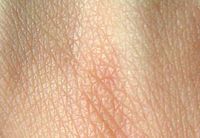
Photo from wikipedia
Histologic differentiation of melanoma in situ (MIS) from solar keratosis on chronically sun‐damaged skin is challenging. The first‐line immunostain is usually MART‐1/Melan‐A, which can exaggerate the epidermal melanocytes, causing a… Click to show full abstract
Histologic differentiation of melanoma in situ (MIS) from solar keratosis on chronically sun‐damaged skin is challenging. The first‐line immunostain is usually MART‐1/Melan‐A, which can exaggerate the epidermal melanocytes, causing a diagnostic pitfall for MIS. By comparing MART‐1 and SOX10 immunostaining, we scored the percentage of epidermal melanocytes per 2‐mm diameter fields in pigmented actinic keratosis (n = 16), lichenoid keratosis (n = 7), junctional melanocytic nevus (n = 6), keratosis with atypical melanocytic proliferation (n = 17) and MIS (n = 10). These cases represented an older population (68 years median age) and the head and neck (50%) was the most common anatomic site. MART‐1 score was significantly higher than SOX10 (P value <.05) in solar keratoses, but showed no difference in detecting melanocytic proliferations, demonstrating their equal detection rate of melanocytes. The sensitivity of both MART‐1 and SOX10 was 100%, while their specificities were 17% and 96%, respectively. These results show that SOX10 is more specific than MART‐1 in distinguishing epidermal melanocytes on sun‐damaged skin by avoiding overdiagnosis of melanoma.
Journal Title: Journal of Cutaneous Pathology
Year Published: 2018
Link to full text (if available)
Share on Social Media: Sign Up to like & get
recommendations!